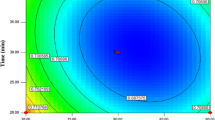Abstract
The aim of this study was to investigate the optimal conditions to process vitamin D2-fortified shiitake mushrooms through UV irradiation for industrial processing. Response surface methodology was used to identify the optimum conditions of the following highly influential factors on vitamin D2 synthesis: temperature, UV dosage, and moisture content. The optimal conditions of those variables were 40.56 °C, 36.27 kJ/m2, and 80.46%, respectively, and UV dosage was the most effective variable. The amount of vitamin D2 obtained under the optimal conditions was 29.87 ± 1.38 μg/g (dry mass: DM) which was well matched with the predicted value of 32.33 μg/g DM. The effects on the texture and color of shiitake mushrooms were also evaluated after the fortification process under the optimal conditions, and no adverse effects were observed compared to those of fresh shiitake mushrooms.


Similar content being viewed by others
References
Jasinghe VJ, Perera CO, Barlow PJ. Bioavailability of vitamin D2 from irradiated mushrooms: an in vivo study. Brit. J. Nutr. 93: 951 (2005)
Holick MF. The vitamin D deficiency pandemic and consequences for nonskeletal health: mechanisms of action. Mol. Aspects. Med. 29: 361–8 (2008)
Jasinghe VJ, Perera CO. Distribution of ergosterol in different tissues of mushrooms and its effect on the conversion of ergosterol to vitamin D2 by UV irradiation. Food Chem. 92: 541–546 (2005)
Chailurkit LO, Kruavit A, Rajatanavin R. Vitamin D status and bone health in healthy Thai elderly women. Nutrition 27: 160–164 (2011)
Bischoff-Ferrari H. Vitamin D—from essentiality to functionality. Int. J. Vitam. Nutr. Res. 82: 321–6 (2012)
Ko JA, Lee BH, Lee JS, Park HJ. Effect of UV-B exposure on the concentration of vitamin D2 in sliced shiitake mushroom (Lentinus edodes) and white button mushroom (Agaricus bisporus). J. Agr. Food Chem. 56: 3671–3674 (2008)
Saif A, Wende K, Lindequist U. In vitro bone inducing effects of Lentinula edodes (shiitake) water extract on human osteoblastic cell cultures. Nat. Prod. Bioprospect. 3: 282–287 (2013)
Gu YH, Belury MA. Selective induction of apoptosis in murine skin carcinoma cells (CH72) by an ethanol extract of Lentinula edodes. Cancer lett. 220: 21–28 (2005)
Kim MJ, Lee JH, Lee JS. Effect of ultraviolet-B irradiation on antioxidative properties of aqueous extracts from shiitake (Lentinus edodes) mushrooms. Int. J. Food. Sci. Tech. 49: 2276–2282 (2014)
Jasinghe VJ, Perera CO. Ultraviolet irradiation: The generator of Vitamin D2 in edible mushrooms. Food Chem. 95: 638–643 (2006)
Mau J L, Chen PR, Yang JH. Ultraviolet irradiation increased vitamin D-2 content in edible mushrooms. J. Agr. Food Chem. 46: 5269–5272 (1998)
Perera CO, Jasinghe VJ, Ng FL, Mujumdar AS. The Effect of Moisture Content on the Conversion of Ergosterol to Vitamin D in Shiitake Mushrooms. Dry Technol. 21: 1091–1099 (2003)
Jasinghe VJ, Perera CO, Sablani SS. Kinetics of the conversion of ergosterol in edible mushrooms. J. Food Eng. 79: 864–869 (2007)
Baş D, Boyacı İH. Modeling and optimization I: Usability of response surface methodology. J. Food Eng. 78: 836–845 (2007)
Hwang KT, Jung ST, Lee GD, Chinnan MS, Park YS, Park HJ. Controlling molecular weight and degree of deacetylation of chitosan by response surface methodology. J. Agr. Food Chem. 50: 1876–1882. (2002)
Sahin S, Aybastier O, Demir C. Optimization of Ultrasonic-Assisted Extraction of Quercetin and Cyanidin from Pyracantha Coccinea and Their Scavenging Effect on Free Radicals. J. Food Biochem. 40: 472–479 (2016)
Wu WJ, Ahn BY. Statistical Optimization of Ultraviolet Irradiate Conditions for Vitamin D-2 Synthesis in Oyster Mushrooms (Pleurotus ostreatus) Using Response Surface Methodology. Plos One 9 (2014)
Simon RR, Phillips KM, Horst RL, Munro IC. Vitamin D Mushrooms: Comparison of the Composition of Button Mushrooms (Agaricus bisporus) Treated Postharvest with UVB Light or Sunlight. J. Agr. Food Chem. 59: 8724–8732 (2011)
Kotwaliwale N, Bakane P, Verma A. Changes in textural and optical properties of oyster mushroom during hot air drying. J. Food Eng. 78: 1207–1211 (2007)
Wang HC, Zhang M, Mujumdar AS. Comparison of Three New Drying Methods for Drying Characteristics and Quality of Shiitake Mushroom (Lentinus edodes). Dry Technol. 32: 1791–1802 (2014)
Nakatsu S, Kohyama K, Watanabe Y, Shibata K, Sakamoto K, Shimoda M. Mechanical properties of softened foodstuffs processed by freeze–thaw infusion of macerating enzyme. Innov. Food Sci. Emerg. 16: 267–276 (2012)
Zivanovic S, Busher R, Kim KS. Textural changes in mushrooms (Agaricus bisporus) associated with tissue ultrastructure and composition. J. Food Sci. 65: 1404–1408 (2000)
Zhang Y, Wu WJ, Song GS, Ahn BY. Optimization of Ultraviolet Irradiate Conditions for Vitamin D2 Synthesis in Shitake Mushrooms (Lentinula edodes) by Using Response Surface Methodology. J. Appl. Biol. Chem. 58: 25–29 (2015)
Acknowledgement
This work was supported by a grant from the Institute of Biomedical Science & Food Safety and the School of Life Sciences and Biotechnology for BK21PLUS, Korea University and High Value-added Food Technology Development Program, funded by the Ministry of Agriculture, Food and Rural Affairs (MAFRA) (114021021HD020).
Author information
Authors and Affiliations
Corresponding authors
Rights and permissions
About this article
Cite this article
Won, D.J., Kim, S.Y., Jang, C.H. et al. Optimization of UV irradiation conditions for the vitamin D2-fortified shiitake mushroom (Lentinula edodes) using response surface methodology. Food Sci Biotechnol 27, 417–424 (2018). https://doi.org/10.1007/s10068-017-0266-0
Received:
Revised:
Accepted:
Published:
Issue Date:
DOI: https://doi.org/10.1007/s10068-017-0266-0




